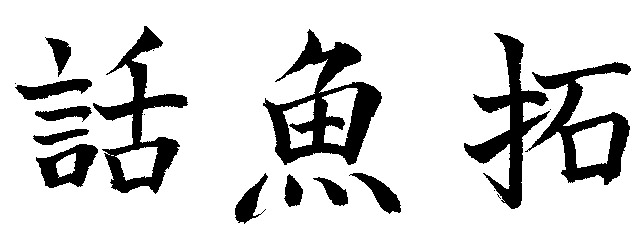
Hanashi is a Japanese word that means narrative or story. I call my style of artwork Hanashi gyotaku because each piece usually tells some kind of story. For me, gyotaku is more than simply a way of creating pictures of fish. It gives me a unique vehicle to explore many facets of the human experience – philosophy, scientific knowledge, and awareness and appreciation of the world around us. The inspiration for these connections usually begins with knowledge of natural history. This foundation leads me to think about a story the fish can tell. As a narrative story unfolds in my mind, the approach to a new gyotaku composition also develops. As I work, the ideas for the inked composition and a written narrative build on one another, enhancing the creative process and enriching the total outcome.
This combination of artwork and written narrative began with the piece Wu-wei Rainbow Trout in the year 2000. A friend, an avid trout fisherman, saw a small reproduction of the piece and asked for a copy. I sent one to him, but realized that although he would understand very well the piece’s natural history theme (a trout rising from its lie to feed), the companion theme of an important Taoist philosophical tenet (action through non-action) contained in both the trout’s behavior and the Chinese calligraphic inscription would probably not be immediately apparent to him. So I wrote the narrative to relate the entire story portrayed by the piece. Why hide its deeper meaning?
Writing and sharing that first narrative was rewarding, so I continued the process. Many gyotaku that I had already created had stories to tell, so I wrote about them. I approached new compositions with new themes that enlarged my perspective and led to further artistic growth. Yet at the same time, this led to a mental conflict. Was I using the written narratives as a crutch to prop up inadequate, mediocre art? Many times I’ve heard the Western art critics’ pronouncements about how a piece of visual art should be able to stand and communicate on its own, without the artist needing to provide any kind of verbal exposition.
Nevertheless, I continued to create gyotaku paired with narratives because I enjoyed it and saw some value in the approach. Yet, the mental tension about the true nature of art persisted and I could not resolve it. Now in hindsight, I clearly see that this conflict was a precious gift -- a Zen koan tailored just for me. A koan is a riddle or paradox that cannot be solved by simple rational thought. Instead, the solution often comes in a flash of transcendental insight. In traditional Zen practice, the mental breakthrough that leads to resolution of a difficult paradox is called satori. Satori is a flash of enlightenment in which one escapes the tyranny of dualities and accumulated prejudices and gains a different perspective of reality.
I mulled over this conflict for eight years, trying to rationalize my artistic approach. The breakthrough – my own personal satori – came when I was creating the piece entitled Four Await (see Gallery 9). This piece’s theme is inextricably intertwined with the peculiarities of language. The initial inspiration for the composition came to me more than a year before I actually secured the fish to create the piece, so I had a lot of time to develop and refine my thinking about how I would execute the work – both the pictoral depiction and the written narrative. It also provided ample time for my mental conflict to grow considerably. I worked on the printing of the piece over a period of several days and immediately after completing it, the transcendent breakthrough came quite suddenly and unexpectedly. Writing this more than six months later, it is hard to remember, let alone describe, exactly what I felt. What I remember best is a moment, all too fleeting, of extreme exhilaration and a profound feeling of oneness, not just of what I had previously viewed as two separate parts of my art practice, but with the whole universe. It was a profound realization that the work was neither one part nor the other, but rather was both, that one was not complete without the other. The yin pictoral presentation needed the yang verbal description not only for completeness, but for total fulfillment. This seems only logical and you might think that I could well have rationally come up with this much earlier without all the fuss, but the insight gained at that moment was far more profound than I can describe in words. At that moment, I truly felt the dissolution of all kinds of dualities-- between pictoral art and written narrative, between predator and prey portrayed in the piece, beween life and death, and between me and the rest of the universe. I felt an inseparable, deep connection with everything. In a brief state of euphoric glee, I cried tears of joy and simultaneously laughed out loud. My conflict was not reality, it was what my mind had created!
With this new perspective, I began to use the name Hanashi gyotaku for this style of gyotaku. With that name, I celebrate the two inseparable facets of my work, but more importantly, the transcendent breakthrough that led me to a fuller understanding and appreciation of this artistic path and so much more.